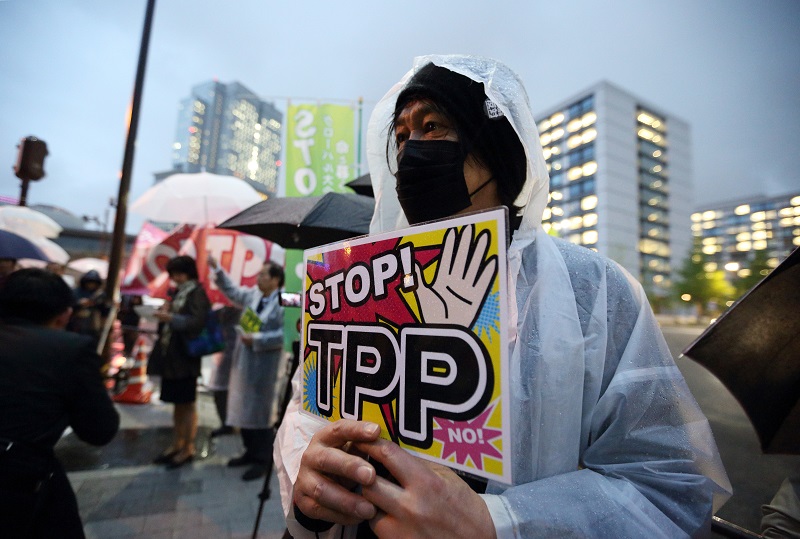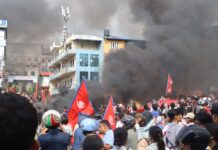Neoliberalism on steroids – TPP is also a geopolitical weapon for US and Japanese capitalism against China
David Hundorf, chinaworker.info
At late night negotiations in Atlanta the Trans-Pacific Partnership (TPP) was finally agreed between the US and 11 other governments on 5 October. The TPP grants major new powers to multinational companies, who have been lobbying furiously for a deal, in what can only be described as neoliberalism on steroids. Its supporters describe TPP as addressing “21st Century trade issues” – many of which actually are not really about trade but rather about protecting investor rights, financial sector liberalisation, and limiting the powers of governments. Opponents of the TPP, which includes the CWI, warn it will lead to higher food and drug prices, more privatisation and outsourcing.
The TPP’s architects claim it will add US$280 billion to member countries’ GDP by the year 2025. But such projections should be viewed sceptically. Capitalist governments have a long history of using the banner of free trade to attack workers’ rights and subject weaker economies to the dictates of the biggest powers. As we’ve seen from other international and regional trade deals, it is generally the rich and especially big corporations who gain while the poor lose out.
The TPP groups together the United States, Australia, Singapore, New Zealand, Chile, Brunei, Canada, Malaysia, Mexico, Peru, Vietnam and Japan. These economies have a combined population of 600 million and account for about 40 percent of global GDP. Within this roll call there are obviously two ‘giants’ – the US and Japan – alongside what are mostly much smaller economies. This tells us a lot about the real aim of the TPP, which is a joint venture between Washington and Tokyo to push back against China’s growing influence in the decisive Asia-Pacific region.
“ABC”
President Obama gave the game away when he said after the TPP deal was clinched: “When more than 95 percent of our potential customers live outside our borders, we can’t let countries like China write the rules of the global economy. We should write those rules…”
This has led to the TPP being nicknamed ABC – “Anyone But China”. Many of its provisions, which aim to roll back the state sector and spur a new wave of privatisations, are also intended to keep China out.
It is an attempt to construct an economic bloc to underpin the new military alliances that are behind the rebalancing or ‘pivot’ of US imperialism on the Asian continent. The ‘pivot’ is the US response to China’s growing economic, financial and military power. The US is planning to shift 60 percent of its naval power to the region by the year 2020, and to upgrade its network of military bases and defence agreements. The decision of the Japanese parliament in September, in the face of massive protests, to adopt a new military law allowing it to fight in overseas wars is another aspect of the ‘pivot’.
China is responding with a major military revamp and a more muscular foreign policy under its nationalist leader Xi Jinping. It is countering the US ‘pivot’ and the TPP by launching a series of grand economic and diplomatic projects for Asia and beyond, including the ‘Road and Belt Initiative’ aimed at constructing economic corridors across Eurasia, Southeast Asia and the Indian Ocean. Beijing hopes to create a pro-China economic sphere based on Chinese state-backed investments in transportation routes and energy infrastructure.
Rival blocs
China is also stepping up its efforts to launch a rival Asian trade agreement, the Regional Comprehensive Economic Partnership (RCEP), involving the ten ASEAN economies plus China, Japan, South Korea, India, Australia and New Zealand. RCEP excludes the US! At the same time, both Beijing and Washington are flirting with potentially disastrous consequences by boosting right-wing nationalism and an arms race across the continent. This is a new ‘cold war’ in outline, but rather than two clearly defined blocs as was the case in the historical conflict between the capitalist US and Stalinist Russia, today’s blocs are looser and more unstable.
Japanese capitalism has been increasing its investments across Asia and shifting away from China as a production base. The right-wing government of Shinzo Abe hopes the TPP will lead to an even bigger shift of manufacturing investment away from China into TPP members like Vietnam and Malaysia. The US-based Brookings Institution predicts “trade diversions” if China is shut out of the TPP as Washington and Tokyo intend. “Countries and businesses will reorient supply chains… to take advantage of the new market access opportunities to be created among TPP members,” says Joshua Meltzer of Brookings.
At the same time, further political headwinds await the TPP, which has yet to be ratified by parliaments in its 12 members states. While four members are de facto one-party states – making nonsense of US-Japan claims that TPP is a “democratic bloc” – popular resistance can grow once the full impact of the pact becomes public knowledge. Even Abe says the deal signed in Atlanta is “just the start”.
The TPP takes pro-big business trade and investment policies to a new and unprecedented level. The fact that its contents are still largely a secret says a lot about how undemocratic and potentially toxic the TPP is. It aims to force open previously sheltered markets to financial speculation despite irrefutable evidence that such policies act as a trigger of financial crises.
The TTP will also block government subsidies to weaker sectors of the economy and roll back the role of state-owned enterprises. This has been seized upon by Abe and the Japanese capitalists as a weapon to force the pace of neoliberal restructuring of the Japanese economy – a weapon against the Japanese masses. This is similar to how the neoliberal EU and Euro (single currency) have been used by the capitalists against the working classes of Europe, most graphically in the case of Greece. Ironically, in China too, there are voices within the government urging a positive stance towards eventual TPP membership, saying it could help to facilitate Xi Jinping’s ‘painful’ economic restructuring.
One of the TPP’s most perfidious features is the investor-state dispute settlement (ISDS), which empowers corporations to sue governments for any alleged financial losses as a result of government legislation. The TPP’s clauses on services open the door to sweeping privatisation in areas such as education, transport and healthcare. A major stumbling block at the Atlanta talks was the attempt by the Obama administration, acting on behalf of the big drug companies, to insert stringent US patent laws into the deal. This was resolved by a messy compromise, but the outcome could still mean costlier medicine for the masses in poorer TPP countries, which rely on strong generic drug industries.
Growing resistance
Paradoxically, the TPP could face the biggest obstacles inside the US, where already there is considerable popular opposition, as expressed in the presidential campaign of ‘socialist’ candidate Bernie Sanders who called the TPP “disastrous”. This pressure has even forced the Democratic Party front-runner Hillary Clinton to say she opposes the TPP. This is some U-turn! When Clinton was secretary of state (until 2013), she was an ardent supporter of the TPP.
Working people and the poor cannot rely on sections of the capitalist political establishment to conduct an effective struggle against the TPP. What’s needed is for organisations of workers, students, green activists and small farmers to coordinate protests at a national and international level. The alternative to neoliberal corporate-led trade pacts and economic blocs is genuine international cooperation – from below – based on democratic public ownership of our economic resources and a socialist alternative to capitalism.





